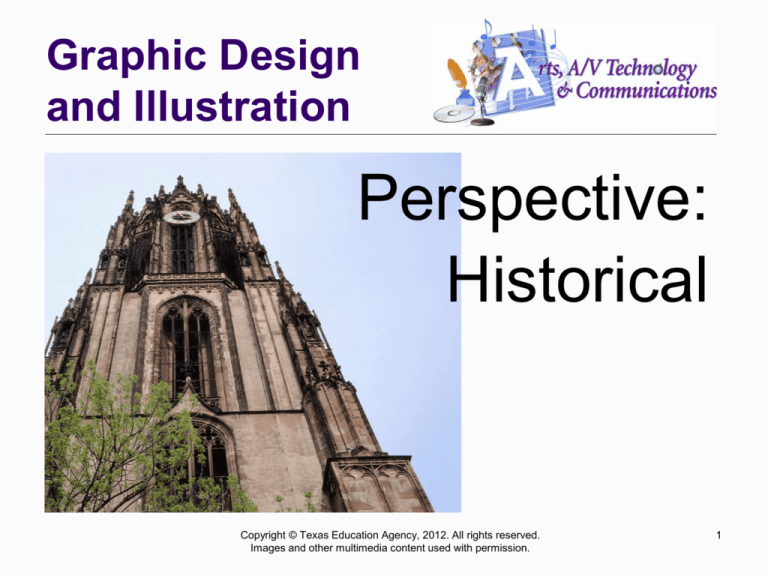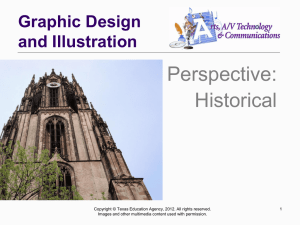
Graphic Design
and Illustration
Perspective:
Historical
Copyright © Texas Education Agency, 2012. All rights reserved.
Images and other multimedia content used with permission.
1
Definition of Perspective
Perspective
is a graphic system
that creates the illusion of depth
and volume on a two-dimensional
surface.
Copyright © Texas Education Agency, 2012. All rights reserved.
Images and other multimedia content used with permission.
2
Artists use six main
techniques to give their
artworks perspective.
(1) They overlap objects, where one object
covers part of a second object, and the first
object seems to be closer to the viewer.
(2) They include differences in size, where
large objects appear to be closer to the viewer
than small objects.
Copyright © Texas Education Agency, 2012. All rights reserved.
Images and other multimedia content used with permission.
3
Artists use six main
techniques to give their
artworks perspective.
(3) They place objects at different levels on the
picture plane. Objects that are lower on the
picture plane appear closer to the viewer than
objects placed further up on the picture plane.
(4) They include differences in detail. Things
that are further away have less detail.
Copyright © Texas Education Agency, 2012. All rights reserved.
Images and other multimedia content used with permission.
4
Artists use six main
techniques to give their
artworks perspective.
(5) They alter the value and intensity of colors.
Objects further away are less vivid, duller, or
flatter in color.
(6) They incorporate converging lines to show
distance and depth.
To create the illusion of forms and depth, artists
must try to represent the way we perceive
things in real life.
http://www.glencoe.com/sec/art/art_talk/students/chapter5.php/tx
Copyright © Texas Education Agency, 2012. All rights reserved.
Images and other multimedia content used with permission.
5
Art Before Perspective
The system of perspective we take for granted
today is a relatively recent discovery in artistic
history. Before the 14th Century little to no
attempts were made to realistically depict the
three-dimensional world in art in the way in
which we are now accustomed to seeing it.
The art of the Byzantine, Medieval, and Gothic
periods was rich and beautiful, but the images
made no attempt to create the illusion of depth
and space.
Copyright © Texas Education Agency, 2012. All rights reserved.
Images and other multimedia content used with permission.
6
The Calling of the Apostles
c.1308-1311
Duccio di Buoninsegna
The Italian masters Giotto (c. 1267 – 1337) and Duccio
(c. 1255-1260 – c. 1318-1319) began to explore the
idea of depth and volume in their art and can be
credited with introducing an early form of perspective,
using shadowing to great effect to create an illusion of
depth, but it was still far from the kind of perspective
we are used to seeing in art today.
Copyright © Texas Education Agency, 2012. All rights reserved.
Images and other multimedia content used with permission.
7
Masaccio (1401 – 1428) the first great painter of the
early Renaissance period, was the first artist who
demonstrated full command of the new rules of
perspective; the figures in his paintings have volume
and the buildings and landscapes realistically recede
into the distance. Masaccio is seen now as being the
initiator of the new style of Florentine Realism.
Copyright © Texas Education Agency, 2012. All rights reserved.
Images and other multimedia content used with permission.
8
Before:
Giotto, Lamentation over Jesus, 1305
http://ftp.aa.edu/lydon/Art07/ArtProject/paige_giotto/index.htm
After:
Raphael. Marriage of the Virgin. 1504
http://www.rosanne-lester.com/projects/art400.html
Copyright © Texas Education Agency, 2012. All rights reserved.
Images and other multimedia content used with permission.
9
Phillip Sousloff
Sculpting in Perspective
Copyright © Texas Education Agency, 2012. All rights reserved.
Images and other multimedia content used with permission.
10
What other
perspective
techniques is
Phillip using in this
sculpture?
Copyright © Texas Education Agency, 2012. All rights reserved.
Images and other multimedia content used with permission.
11
2-point perspective
Notice how he uses size to show
perspective and depth
Copyright © Texas Education Agency, 2012. All rights reserved.
Images and other multimedia content used with permission.
12
Copyright © Texas Education Agency, 2012. All rights reserved.
Images and other multimedia content used with permission.
13
Landscape perspective
Copyright © Texas Education Agency, 2012. All rights reserved.
Images and other multimedia content used with permission.
14





